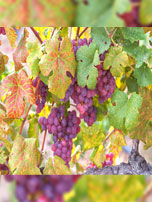SHAHEED KARTAR SINGH SARABHA AYURVEDIC MEDICAL COLLEGE & HOSPITAL
Affiliated to Guru Ravidas Ayurved University, Hoshiarpur Punjab
Affiliated to Guru Ravidas Ayurved University, Hoshiarpur Punjab

Botanical Name : Vitis vinifera Linn.
Family : Vitaceae
Introduction :
Vitaceae (plants of the vine tribe).
Latin name : Vitis = name of wine; vinifera = which produces wine.
Scientific classification: Grapes belong to the family Vitaceae. The European grape is classified as Vitis vinifera, the northern fox grape asVitis labrusca, the summer grape as Vitis aestivalis, the riverbank grape as Vitis riparia, and the muscadine grape as Vitis rotundifolia.
Grape, common name of an edible fruit in the buckthorn family, and of the vines that produce the fruit. The European grape has been used as food since prehistoric times. Grape seeds have been found in remains of lake dwellings of the Bronze Age in Switzerland and Italy and in tombs of ancient Egypt. Botanists believe that the Caspian Sea region was the original home of the European grape. Distribution of seeds by birds, wind, and water carried the plant westward to the Asian shores of the Mediterranean. Grape culture, practiced in Palestine during biblical times, was introduced in the Mediterranean region by seagoing Phoenicians. The ancient Greeks cultivated grapes, and use of the fruit was later adopted by Rome and its tributary territories.
The European grape is now commercially cultivated in warmer regions all over the world, particularly in western Europe, the Balkans, California, Australia, South Africa, and parts of South America. It was introduced to eastern North America during colonial times, but in those days grape cultivation failed due to the attacks of diseases and pests. Successful grape varieties of the eastern United States, such as Concord and Delaware, are strains developed from hybrids between the European grape and several native species, particularly the northern fox grape, the summer grape, the riverbank grape, and the muscadine grape. Eastern U.S. grapes are characterized by a juicy layer between the skin and pulp of the fruit, which permits easy removal of the skin. Grape varieties, whether European or eastern U.S., are classified according to their ultimate use. Grapes used to make table wine must have relatively high acidity and moderate sugar content; those used for dessert wines and other sweet wines must have high sugar content and moderate acidity. Table grapes must be low in both acidity and sugar content and must conform to definite standards of size, color, and shape. Grapes used to make juices and jellies must have a pronounced flavor combined with high acidity and moderate sugar content. Raisin grapes are preferably seedless, with high sugar content and low acidity. European varieties are considered superior to eastern U.S. varieties for use as table wines, table grapes, dessert wines, and raisins; eastern U.S. grapes are preferred for juices and jellies.
Grapevines are stems that climb on walls and fences by means of specialized supporting organs, called tendrils. Palmately veined leaves arise alternately along the stem. In most varieties, tendrils arise opposite two of every three successive leaves. Flowers, usually greenish, are borne in clusters and have staminate and pistillate flowers sometimes occurring on separate plants. Fruit is borne on 2-year-old canes, which are removed after harvesting the grapes.
Grapevines planted in commercial vineyards are usually started in spring from year-old rooted or grafted cuttings. Roots are trimmed to 7.6 to 10 cm (3 to 4 in) for convenience, and vines are planted 2.4 to 3 m (8 to 10 ft) apart. All the shoots except the strongest one on the vine are later pruned; the remaining shoot is cut back to two or three buds. This process is repeated in the spring of the following two years. The resulting plant develops a strong main stem, resembling a small tree trunk, before it is allowed to bear fruit. Such strong stems are able to stand erect without support. During the expansion of the main stem, the vine is loosely tied to an upright support 1.8 m (6 ft) tall or higher. After the fruit-producing stage is reached, the vines are carefully pruned to reduce the number of buds. Shoots that develop from the remaining buds are more prolific and bear grapes of high quality.
Grapes are attacked by a great number of insect pests and plant diseases, of which the most common are black rot and downy mildew.
Names in different Indian languages :
English : Wine Grape,European Grape,grape
Hindi : Dakh,drakh,Angoor
Kannada : Draksa
Malayalam : munthiri
Sanskrit : Draakshaa,mridvika,draksha
Tamil : Kotumuntiri,tiratcai
Telugu : Draksa
Unani : Angoor
Synonyms :
Draakshaa, Go-stani,Mrdvikaa, Charuphala Krishna, Tapaspriya, Rasala,
Amrutphala, Phalottarna, Madhurasa.
Dried fruit—Daakh, Munnakaa, Kishmish
Black grape: Mrudvika, Gostani. Haimavati, Mrudvi, Kashmiri,
Shalavcerya, Madhuli, Amrutrasa.
Morphology :
It is an ascending creeper.
Leaves – resemble bitter gourd but have fine hair on them. At the centre of the leaf, there are 4 to 5 veins in pairs, flowers – greenish, fragrant and in clusters.
Fruits are oblong, having 4 -S seeds.
Flowering occurs in spring followed by fruiting in summer. Now-a-days many varieties are available which have been extensively studied
Chemical constituents :
tannins, tartrates, inositol, carotenes, choline, sugars, minerals
Properties :
Grape is described as the best fruit because of its extremely beneficial properties
Guna: snigdha, guru, mridu;
Rasa: madhur;
Vipaka: madhur;
Virya: sheeta.
Karma :
Sukha virechana, hridya, vrishya, balya, vranaropana, caksusya, varnya
Liver tonic, carminative, digestive,astingent,bitter, aphrodisiac, decreses lipid cholestrol level, blood purifier
Srotogamitva :
Dosha: Vataghna, pittaghna, vatapittashamak
Dhatu: Mansa, shukra, rakta, saptadhatu, rasa.
Mala: Purisha (laxative), blood purifier
Organ: Heart, uterus
Indication :
Raktapitha, swasa, kasa, kusta, vrana, trishna,
Anemia, jaundice, dyspepsia, constipation, haemorrhagic diseases, gout, cough, dyspnoea,
Part used :
Whole plant, mainly dried fruit
Dosage :
Leaf juice 10-15 ml
Powder 2-4 g
Decoction 50-100 ml
Uses :
Useful in thirst, bleeding disorders, burning, gout, pthisis, pleurisy, tuberculosis, cough, asthma, dysuria, burning micturition, wasting etc.
